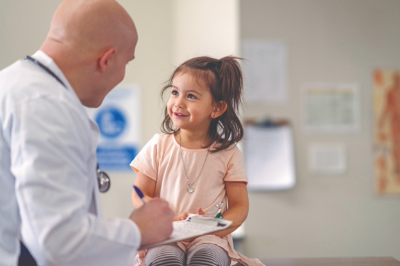
Expert Urologic Care for Infants, Children, and Teens Across Long Island
The Pediatric Urology program at Stony Brook Medicine provides comprehensive, family-focused care for children across Long Island and Suffolk County. Our fellowship-trained pediatric urologists specialize in a wide variety of both common and complex urologic conditions. We work closely with specialists in Pediatric Nephrology, Radiology, Surgery, and Neurosurgery to deliver coordinated, high-quality treatment in a comfortable, child-friendly environment.
As a regional leader, Stony Brook is the only hospital in Suffolk County to offer advanced pediatric urologic procedures such as hypospadias repair, complex reconstructive surgery, and minimally invasive robotic surgery, providing expert care close to home.
For additional information, please visit Stony Brook Children's.
Common Pediatric Urology Conditions
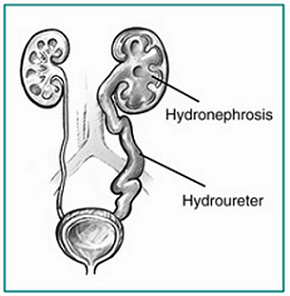 Prenatal Hydronephrosis is a condition that occurs during pregnancy and involves the dilation or stretching of the kidneys.This is one of the most common findings we see prenatally, and is found on 1-2% of all ultrasounds done at 20 weeks.
Prenatal Hydronephrosis is a condition that occurs during pregnancy and involves the dilation or stretching of the kidneys.This is one of the most common findings we see prenatally, and is found on 1-2% of all ultrasounds done at 20 weeks.
Two common issues that cause prenatal hydronephrosis include reflux and obstruction. Reflux is when urine from the bladder goes up into the kidneys, and obstruction is when there is a blockage of urine anywhere from the kidney to the bladder.
Symptoms
Prenatal hydronephrosis does not cause any symptoms. A doctor will find out if a baby has hydronephrosis during an ultrasound.
We provide consultations prenatally throughout pregnancy and will see you in the hospital after delivery to create an individualized treatment plan.
Circumcision is a commonly performed procedure in the newborn period. If you have questions about circumcision, the advantages and disadvantages of circumcision may be discussed with your provider in a no-pressure, evidence-based consultation before coming to a decision. We are happy to offer consultations at many locations across Suffolk County and via telehealth. We also offer circumcisions at many of our offices if you are interested in proceeding with the procedure.
Proper care after a circumcision
It is important that the proper care is taken for the first 2 weeks after circumcision. Please be aware of the following guidelines post-circumcision:
- Apply petroleum jelly or an antibiotic cream
- There may be blood at first (this is normal)
- Keep the penis clean with soap and water
- The area may appear to be red or raw
Circumcision in a male is the surgical removal of the foreskin on the penis. In some cases, too little skin is removed and the penis appears to have not been circumcised or looks asymmetric. Less commonly, the head of the penis may still remain covered and unable to be exposed (hidden penis).
When to see a doctor
A complete circumcision is best accomplished via ambulatory or same day surgery under general anesthesia between six months and one year of age. This allows an appropriate amount of foreskin to be removed and offers the best functional and cosmetic result in a pain-free fashion. See a pediatric urologist to determine if the circumcision needs revision and to weigh out the risks of re-operating against the benefits of improved cosmetic appearance.
Dysuria is described as painful urination and can be associated with a frequent and urgent need to urinate.
Types of Dysuria
- Pain at the initiation of urination (associated with the urethra)
- Pain at the end of urination (associated with the bladder)
When to see a doctor
Visit a doctor if your child is complaining about painful urination or if crying is associated with a wet diaper. Dysuria has common symptoms with many infectious and noninfectious conditions; a pediatric urologist will be able to determine the root cause of the pain and rule out other conditions.
Learn More
A hydrocele is when fluid builds up around the testicle and presents as a bulge in the scrotum. This condition is common in newborn boys and typically goes away by the time the baby reaches 1-year-old.
Symptoms
You may be able to tell if your child has a hydrocele by detecting swelling in the scrotum that worsens with straining or crying, and often improves when a child is sleeping or lying down.
When to see a doctor
See a doctor if your child is experiencing any of the above symptoms. Your doctor will be able to detect a hydrocele through physical examination, or in rare cases, an ultrasound
Treatments we offer
A hydrocele is not always treated. Sometimes a hydrocele will go away on its own. If your baby's hydrocele has not gone away by age 1, then a minor surgery would be needed to drain the excess fluid.
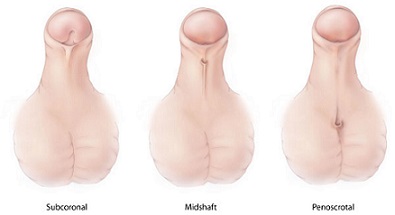 Hypospadias is a common finding at birth that affects the penis. Boys born with hypospadias have a urethral opening (the hole that urine comes out of) in the wrong place. The opening may form close to the tip, along the shaft of the penis, or close to the testicles.
Hypospadias is a common finding at birth that affects the penis. Boys born with hypospadias have a urethral opening (the hole that urine comes out of) in the wrong place. The opening may form close to the tip, along the shaft of the penis, or close to the testicles.
Symptoms
- Urine will flow in an unusual direction
- Associated with chordee, or curvature of the penis
Treatments we offer
- Treatment is not always needed in mild cases (urine will stream in a slightly different direction)
- Surgery to create a new urethra opening (when the child is 6 months old)
- More than one surgery may be required
- It is a good idea to hold off on circumcision (the surgeon can use the skin that is normally removed)
Kidney stones, or nephrolithiasis, develop when substances such as calcium, oxalate, cystine, or uric acid are at high levels in the urine. Some stones may stay in the kidney without causing any issues, but others may attempt to move through the ureter and towards the bladder. This is a condition known as urolithiasis. If the stone gets stuck and blocks urine from passing, it may result in varying levels of pain.
Symptoms:
- Pain in the side, back, and/or groin
- Pain that starts suddenly and comes in waves
- Pain or burning while urinating
- Feeling an intense need to urinate
- Blood in urine
- Gravel or small stones in the urine
Treatment Options:
- Dietary Changes
- Medication
- Stenting
- Extracorporeal Shock wave lithotripsy (ESWL)
- Ureteroscopy
- Percutaneous Nephrolithotomy (PCNL)
- Laser Lithotripsy
Meatal Stenosis is when the opening at the end of the penis (external urethra meatus) becomes narrow due to irritation (ex: rubbing against a wet diaper). Stenosis is more commonly seen in boys between 3-7 years old that are circumcised and is rare in uncircumcised boys.
Symptoms
- Narrow/upward urine stream
- Difficulty directing urine stream
- Painful urination
Treatments we offer
- Meatotomy
- The goal is to enlarge the opening by cutting the skin that covers the meatus
- Procedure takes 15-30 minutes and takes 1-2 days to recover
Neurogenic bladder refers to when the bladder does not function properly because of nerve damage. It is usually caused by a spinal cord injury or spina bifida.
Symptoms
- Urine leakage - not having control over urine coming out
- Urine retention - having trouble releasing urine
- Urinary tract infection (UTI) that causes pain
See a pediatric urologist if your child is having any of the above symptoms. A physical exam will be performed, and your child may have a urine test, urodynamic study, or ultrasound to determine a proper diagnosis.
Treatments we offer
- Bladder retraining - having scheduled times for using the bathroom
- Using a catheter to empty the bladder during the day
- Medicine - to relax the bladder or reduce chance of infection
- Artificial sphincter - a small cuff around the neck of the bladder that can be used to inflate or deflate the bladder
Nocturnal enuresis is the medical term for bedwetting, which is a common childhood problem. Typically, by age 4 children learn to control their bladder during the daytime. Nighttime bladder control takes slightly longer to learn; usually when the child is 5 to 7 years old, however, it is not uncommon for some kids to have difficulty into adolescence.
Causes
- Child’s bladder is maturing slowly
- Child’s bladder holds a smaller amount of urine
- Diminished level of vasopressin (hormone that reduces urine production)
When to see a doctor
Visit a doctor if your child has:
- To urinate frequently/urgently
- Extreme thirst during the day
- Constant bedwetting after weeks or months of being dry
Treatments we offer
- Education and motivational therapy (Primary)
- Medications - Desmopressin is a medication to reduce the amount of urine during sleep (Tertiary)
Learn More
Phimosis refers to tight foreskin that cannot be retracted, and as a result the glans of the penis cannot be exposed. This condition is normal in uncircumcised infant/children, and typically resolves after 7-10 years.
Symptoms
- Appears as a tight ring of foreskin around the tip of the penis
- Cannot fully retract foreskin
Treatments we offer
- Reassurance
- Gentle manual retraction of foreskin
- Topical corticosteroid ointment - used to soften the foreskin
- Circumcision - surgical removal of the foreskin
Just before the birth of a boy, the testes move down into the scrotum. In some cases, one or both of the testes stop short during their descent into the scrotum and remain in the abdominal cavity. We do not know for certain what causes undescended testicle, but we do know that it is associated with prematurity.
Symptoms
Undescended testes do not typically cause any symptoms. Undescended testes are found during an examination shortly after birth or by the pediatrician.
Treatments we offer
In most cases, no treatment is needed and the testicle or testicles will descend to the scrotum by six months of age.
If the testes do not descend on their own by six months of age, then it is unlikely that they would descend in the future. At this point, surgery would be performed to move them to the scrotum, which would improve future fertility and hormone function, as well as reduce future cancer risks for that testicle. Surgery can be completed as soon as 6 months after birth, and no later than 18 months of age.
Ureteropelvic junction (UPJ) obstruction is a partial or complete blockage of urine flow that occurs where the renal pelvis meets the ureter.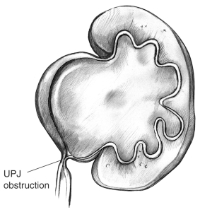
Signs and Symptoms
- Flank pain
- Hydronephrosis
- Abdominal mass
- Urinary tract infection (UTI)
- Kidney stones
When to see a doctor
Most cases will be detected during a prenatal ultrasound screening, and will need further imaging to differentiate between UPJ obstruction and prenatal hydronephrosis.
Visit a doctor if your child is older and experiencing the above symptoms to receive an examination.
Treatments we offer
Treatment may not always be necessary. Poor drainage may only be temporary in children younger than 18 months.
Older children may need the following treatment methods:
- Robotic-assisted laparoscopic pyeloplasty - Using a surgical robot to remove the UPJ and reattach the ureter to the renal pelvis
- Internal incision - Inserting a wire through the ureter to cut the tight and narrow UPJ. A special ureter drain will be left in for a few weeks.
A ureterocele is when the end of the ureter that enters the bladder does not properly develop. With this birth defect, the end of the ureter begins to swell and can stop the flow of urine to the bladder.
Symptoms
- Side, back, or abdominal pain
- Urinary tract infection (UTI)
- Painful urination
When to see a doctor
In most cases, a ureterocele can be detected during a maternal ultrasound before the birth of a child. However, a ureterocele may not be diagnosed until the child is seen for another problem, such as a UTI.
Treatments we offer
- Transurethral puncture - Puncturing and decompressing the ureterocele with the use of a cystoscope (Usually takes 15-30 minutes)
- Removal of the Ureterocele - Surgical removal of the ureterocele and rebuilding of the ureteral flap valve
- Antibiotics - Used to fight against / prevent kidney infection
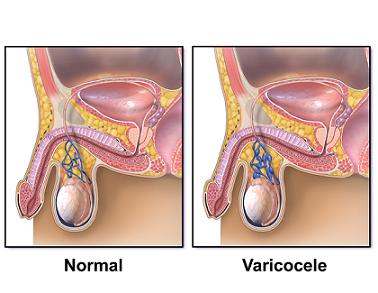 A varicocele is a group of swollen veins located inside the scrotum. Boys can experience varicoceles at any age. Varicoceles may be associated with fertility issues in some men later in life.
A varicocele is a group of swollen veins located inside the scrotum. Boys can experience varicoceles at any age. Varicoceles may be associated with fertility issues in some men later in life.
Symptoms
Varicoceles typically do not cause any pain or symptoms; however, your child may experience the following:
- Dull ache in the testicle
- Swelling in one testicle (more common on the left side)
- Testicles look different sizes
When to see a doctor
Visit a doctor if you are experiencing the symptoms listed above. Your doctor will most likely be able to diagnose a varicocele by an examination.
Treatments we offer
- Pain medicine - Ibuprofen can relieve discomfort
- Wearing tight underwear to support the scrotum
- Surgery to stop the blood flowing into the swollen veins
Vesicoureteral reflux causes the urine to flow in the wrong direction inside of the body.
Normally, the flow of urine goes from the: kidneys → ureter → bladder
The flow of urine in patients with vesicoureteral reflux is: bladder → ureter → kidney
Symptoms
There are no symptoms seen with vesicoureteral reflux.
A doctor usually believes a child has it if they have one of the following conditions:
- Hydronephrosis (swelling of the kidneys)
- Urinary Tract Infection (UTI)
Treatments we offer
- Observation
- Antibiotics - to prevent a UTI
- Surgery - to stop the backflow of urine from the bladder to the kidney
Learn More
Learn more about voiding dysfunction and it's treatments here:
Physicians
 |  |  |  |
| Robert J. Wasnick, MD, FAAP, FACS Professor Pediatric Urology | Rachel Davis, MD Assistant Professor Pediatric Urology | Michael Ernst, MD Assistant Professor Pediatric Urology | Meagan Hartough, MSN, FNP-BC, OCN Nurse Practitioner Pediatric Urology |
Our Locations
Commack
500 Commack Rd, Suite 201B
(Within Stony Brook Medicine's Advanced Specialty Care - Commack)
Holbrook
280 Union Avenue
Lake Grove
4 Smith Haven Mall, Suite 110
(Within Stony Brook Medicine's Advanced Specialty Care - Lake Grove)
Patchogue
450 Waverly Avenue
Riverhead
74 Commerce Drive
Smithtown
260 Middle Country Road
Call (631) 444-6270 to make an appointment today.
Additional Resources:

